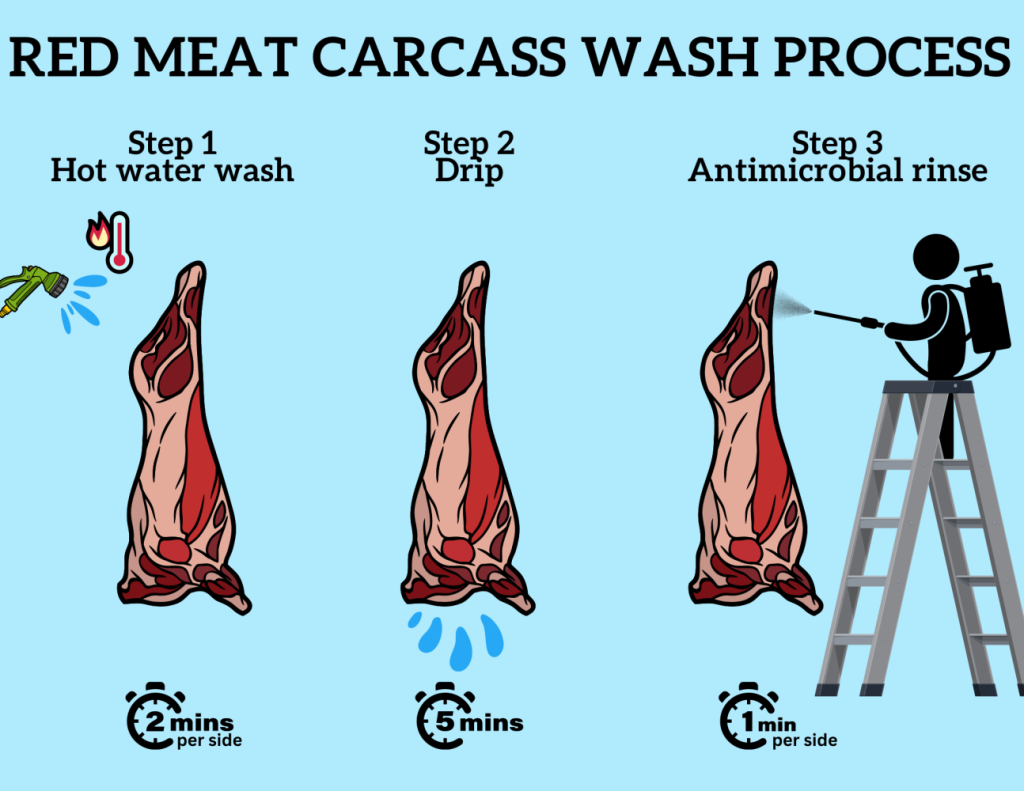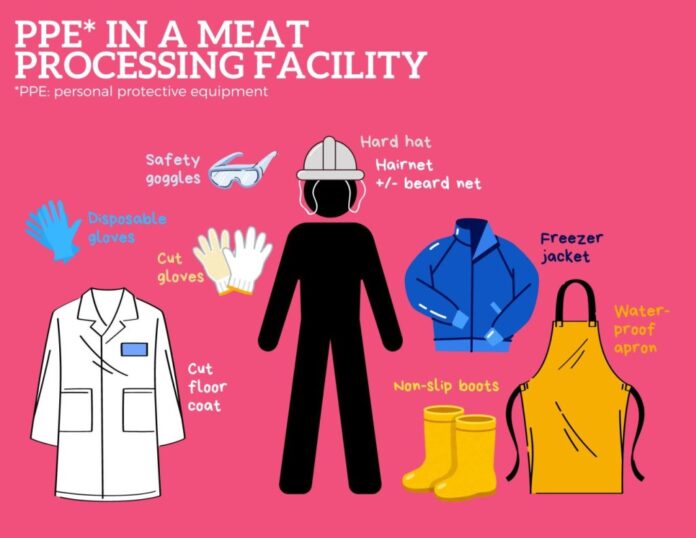This post was written by Emma Zaicow, Purdue University, and was selected as a winning submission in the 2024 College Aggies Online program.
Whether it is the influence of social media trends or of familial, cultural, or religious custom, have you ever found yourself considering washing raw meat before you cook it? To set the record straight, both the USDA and CDC strongly discourage the washing of raw meat before cooking it.

The two big take-aways as to why washing raw meat is inadvisable are:
- As meat is washed, the scattering of water droplets that contain harmful bacteria may lead to bacterial colonization of the surrounding kitchen/cooking surfaces. This could include the clean plates you were planning to serve the meal on!
- As long as meat is cooked to the recommended internal temperature (1), any bacteria will be killed. Washing meat or soaking it in salt, vinegar, or lemon water will not kill bacteria.
But, if those reasons are not enough to convince you, let’s dive into the process of carcass preparation and washing in USDA-inspected facilities. All facilities processing a raw product* to be sold for consumption must have a Hazard Analysis and Critical Control Point (HACCP) Plan, a robust food safety plan. These plans are experimentally backed, that is, there must be proof that the methods used in a facility to prevent food-borne pathogens work. For meat processing establishments, this includes washing carcasses, disinfecting the space and tools used, and wearing personal protective equipment (PPE).
*Note: “raw product” can mean raw meat or even raw fruits, such as those used for juice pressing.
Red Meat Processing/Washing
The term “red meat” includes the products of cattle, pigs, sheep, goats, deer, and other minor species.
Carcass breakdown varies by species but no matter the species, any dirt/debris will be washed off with hot water before cutting begins.
Pig carcasses are typically placed in a scalding water bath that rotates the carcass with paddles. Heat softens the keratin that holds hair and claws in place, so the carcass emerges from the scalder virtually hairless and without claws. Any remaining hair is burnt and scraped off with a clean knife. Cattle, sheep, goats, and deer are skinned carefully, with any dirtied areas beneath the skin getting trimmed off. The head is removed with a clean knife.
The rectum is typically sealed shut by a rubber band or plastic clasp in a process known as “bunging” (7). Internal organs are removed swiftly and by a very skilled hand to prevent leakage of gut contents onto the meat. A USDA meat inspector will evaluate organs to be sold or rendered and those of veterinary importance. Any concerning observations may result in the carcass being retained for veterinary inspection or the carcass may be condemned (required to be disposed of) (3).

From here, the carcass must be split and cleaned before a final inspection by the meat inspector. Carcass washing begins with a hot water wash for at least 2 minutes per side from top to bottom. The carcass is then left to dry for 5 minutes so as not to dilute the antimicrobial solution. The final step includes the application of an antimicrobial spray solution, typically 2% lactic acid (4,5), for at least 1 minute per side from top to bottom (6). The carcass goes through one final inspection and receives a stamp of approval from the USDA meat inspector before it is moved to a chill cooler or to the cut floor for further breakdown.
Poultry Processing/Washing
Poultry carcasses of species like chickens, turkeys, and duck are processed in very similar ways. The carcasses are typically soaked in a hot water bath (scalder) to loosen feathers and dirt/debris. The carcass is then defeathered in a plucking machine, which uses rubber paddles/fingers to rotate the carcass and pull feathers off as it goes by. Either by machine or hand, the head, feet, and internal organs are removed.
Just like for red meat carcasses, a USDA meat inspector evaluates the organs that are either to be eaten or rendered, as well as those that may indicate the animal was sick at its time of death.
The carcass is washed with water and may, depending on the facility, be dunked into a diluted paracetic acid (PAA), cetylpyridinium chloride (CPC), organic acid, or acidified sodium chlorite (ASC) solution (8). The carcass is inspected once more by the meat inspector then placed in a chill cooler or sent right to the cut floor for further breakdown.
The Bottom Line
Excruciating care is taken to ensure that the meat you are buying from USDA-inspected meat processing facilities is safe to consume. Washing raw meat is not only unnecessary, it is dangerous! Cook your meat thoroughly and use an internal meat thermometer to ensure the proper internal temperature has been reached.
References
- Food Safety and Inspection Service. Safe Minimum Internal Temperature Chart | Food Safety and Inspection Service. (n.d.). https://www.fsis.usda.gov/food-safety/safe-food-handling-and-preparation/food-safety-basics/safe-temperature-chart
- Washing raw poultry: Our science, your choice. USDA. (n.d.). https://www.usda.gov/media/press-releases/2019/08/20/washing-raw-poultry-our-science-your-choice
- Post-mortem inspection. (n.d.-b). https://www.fsis.usda.gov/sites/default/files/media_file/2020-08/PHVt-Post_Mortem_Inspection.pdf
- Antimicrobial interventions for Beef. (n.d.-a). https://www.bifsco.org/Media/BIFSCO/Docs/antimicrobial-interventions-for-beef.pdf
- Nkosi, D. V., Bekker, J. L., & Hoffman, L. C. (2021). The Use of Organic Acids (Lactic and Acetic) as a Microbial Decontaminant during the Slaughter of Meat Animal Species: A Review. Foods (Basel, Switzerland), 10(10), 2293. https://doi.org/10.3390/foods10102293
- Antimicrobial spray treatments for red meat carcasses processed in very small meat establishments.(n.d.-a). https://meathaccp.wisc.edu/validation/assets/acid_spray_intervention_booklet_from_penn_state_2005.pdf
- Collins, D. S., Huey, R. J., & Gracey, J. F. (2015). Gracey’s meat hygiene. John Wiley & Sons Inc.
- Ketchumadmin. (2020, July 1). What is chlorinated chicken? is chlorine-washed chicken safe to eat?. Chicken Check In. https://www.chickencheck.in/faq/chlorine-washed-chicken/#:~:text=Common%20antimicrobial%20interventions%20when%20processing,basically%20vinegar%20and%20hydrogen%20peroxide
All posts are the opinion of the author and do not necessarily represent the view of the Animal Ag Alliance.
The post Should you wash meat before cooking it? appeared first on Animal Agriculture Alliance.

